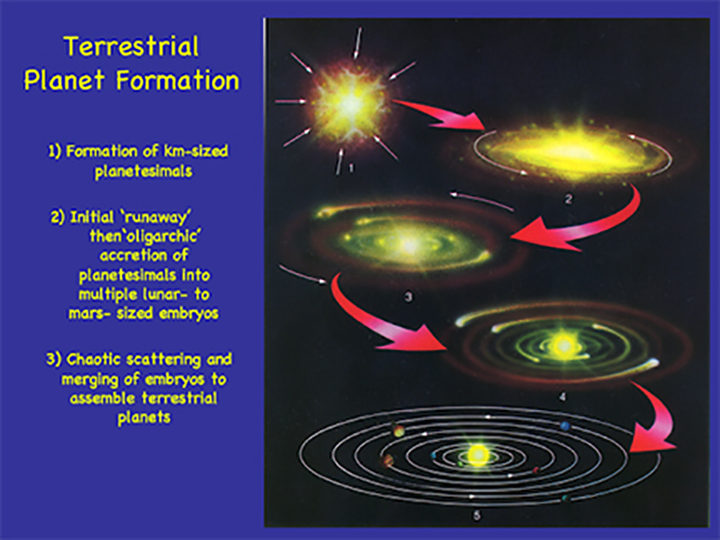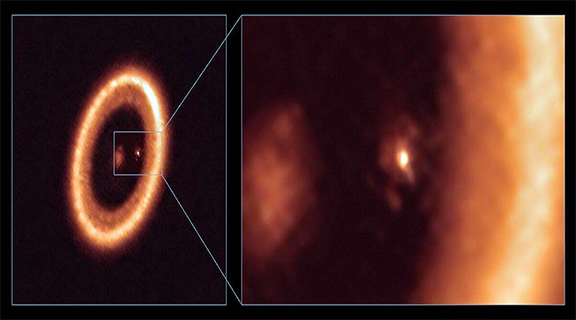Science & Technology
Moon-Forming Regions Around Exoplanets
- 26 Jul 2021
- 5 min read
Why in News
Recently, scientists for the first time have spotted a Moon-Forming Region around a planet beyond our solar system (Exoplanet).
Exoplanets
- An exoplanet or extrasolar planet is a planet outside the Solar System. The first confirmation of detection of exoplanets occurred in 1992. More than 4,400 exoplanets have been discovered till now.
- Exoplanets are very hard to see directly with telescopes. They are hidden by the bright glare of the stars they orbit. So, astronomers use other ways to detect and study exoplanets such as looking at the effects these planets have on the stars they orbit.
Key Points
- Observation & Findings:
- Scientists detected a disc of swirling material accumulating around two exoplanets seen orbiting a young star called PDS 70.
- PDS 70 is located a relatively close 370 light years from Earth.
- A light year is the distance light travels in a year, about 9.5 trillion km.
- It is called a circumplanetary disc, and it is from these that moons are born. The disc around PDS 70c (The Exoplanet), with a diameter about equal to the distance of the Earth to the sun, possesses enough mass to produce up to three moons the size of Earth's moon.
- PDS 70c orbits its star at 33 times the distance of the Earth from the sun, similar to the planet Neptune in our solar system.
- The orange-coloured star PDS 70, roughly the same mass as our Sun, is about 5 million years old. The two planets are even younger. Both planets are similar (although larger) to Jupiter, a gas giant.
- It was around one of the two planets, called PDS 70c, that a moon-forming disc was observed.
- Both planets are still in their youth and are at a dynamic stage in which they are still acquiring their atmospheres.
- Scientists detected a disc of swirling material accumulating around two exoplanets seen orbiting a young star called PDS 70.
- Instrument Used:
- They used the Atacama Large Millimeter/submillimeter Array (ALMA) observatory in Chile's Atacama desert. It is the most complex astronomical observatory ever built on Earth.
- Teams from North America, East Asia, and Europe merged projects to develop this breakthrough scientific instrument.
- It uses 66 high-precision dish antennas of two sizes: 54 of them are 12 meters across and 12 of them are 7 meters across.
- They used the Atacama Large Millimeter/submillimeter Array (ALMA) observatory in Chile's Atacama desert. It is the most complex astronomical observatory ever built on Earth.
- Other Moon Forming Regions:
- No circumplanetary discs had been found until now because all the known exoplanets resided in “mature” – fully developed – solar systems, except the two infant gas planets orbiting PDS 70.
- In our solar system, the impressive rings of Saturn, a planet around which more than 80 moons orbit, represent a relic of a primordial moon-forming disc.
- Planet & Moon Formation:

- Stars burst to life within clouds of interstellar gas and dust scattered throughout galaxies. Leftover material spinning around a new star then coalesces into planets, and circumplanetary discs surrounding some planets similarly yield moons.
- The dominant mechanism thought to underpin planet formation is called “core accretion''.
- Core accretion occurs from the collision and coagulation of solid particles into gradually larger bodies until a massive enough planetary embryo is formed (10-20 Earth masses) to accrete a gaseous envelope.
- In this scenario, small dust grains, coated in ice, gradually grow to larger and larger sizes through successive collisions with other grains.
- This continues until the grains have grown to a size of a planetary core, at which point the young planet has a strong enough gravitational potential to accrete gas which will form its atmosphere.
- Some nascent planets attract a disc of material around them, with the same process that gives rise to planets around a star leading to the formation of moons around planets.







